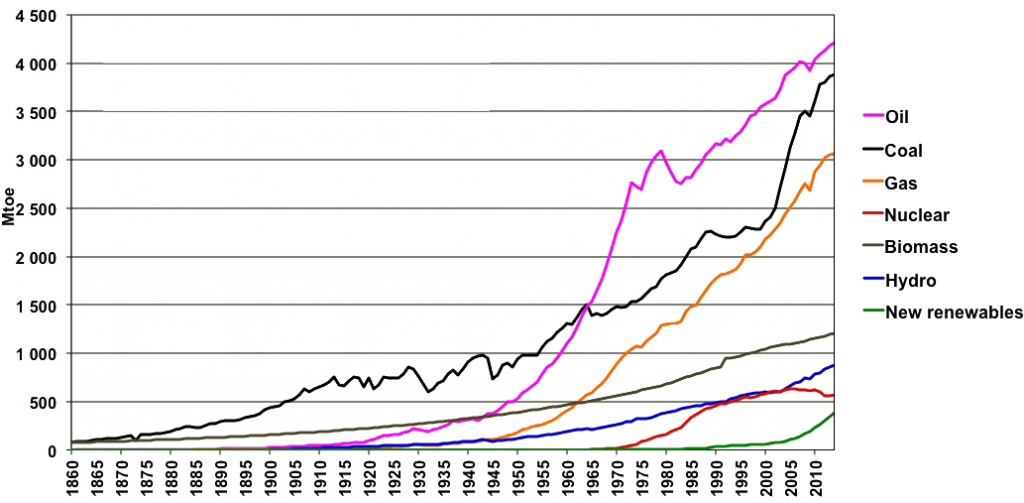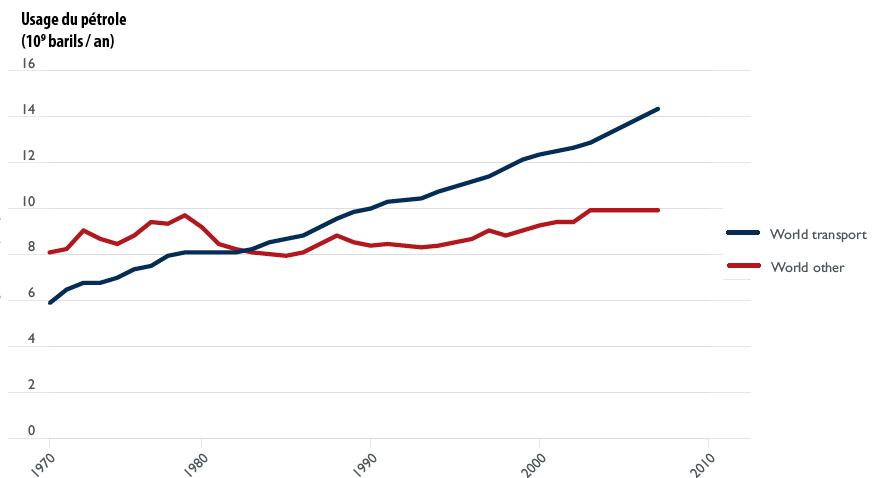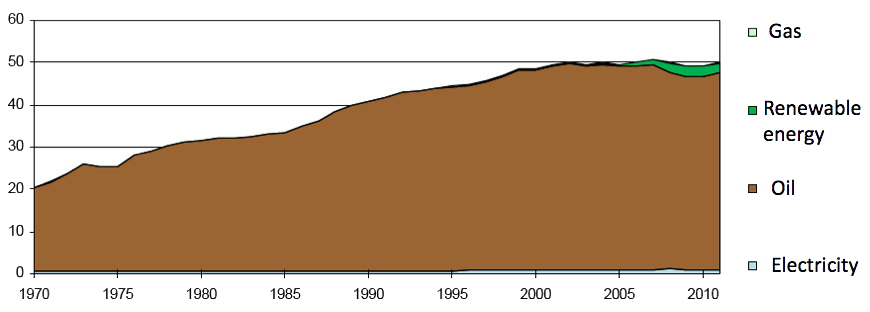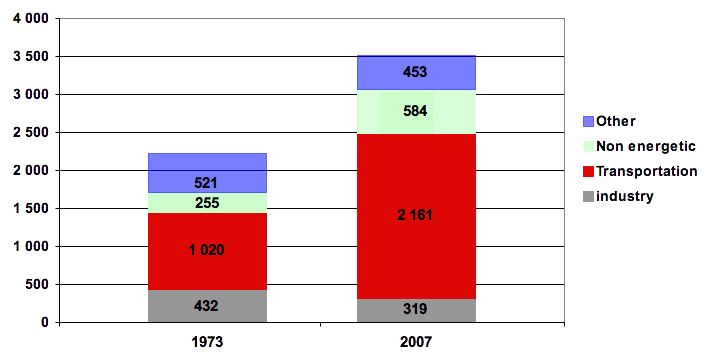Before we even answer that question, we can be sure of one thing: oil must be a delight, because since we have begun to use some we have always wanted more!

World consumption of each significant energy, excluding wood, from 1860 onwards, in million tonnes oil equivalent
(one tonne oil equivalent = 42 gigajoules = 11600 kWh).
Fashionnable renewable energies (wind, solar, etc) are negligible here.
Source Shilling et al., 1977, and BP Statistical Review, 2015
Actually, if we now look at the average consumption per capita, we come up with a first surprise: since 1979 oil consumption… decreases !

World average consumption per capita of each significant energy from 1860 onwards, in kWh par year.
Surprise ! As the world oil consumption has kept rising after the oil shocks, the consumption per capita has decreased since then, and is about stable since 1980.
Source Shilling et al., 1977, BP Statistical Review, 2015, and United Nations for the population.
And what is all this oil used for ? Well basically… getting heat ! Because if we can so easily drive our car around, it is thanks to the famous internal combustion engine, which has, for more than a century, transformed heat into movement. And because of this basic characteristic – oil can be burnt – it is mobility that absorbs more than half (60% roughly) of all the oil extracted from the underground.

Breakdown of the world oil consumption by usage, in billion barrels per year.
Source : « Transport energy futures: long-term oil supply trends and projections », Bureau of Infrastructure, Transport and Regional Economics (BITRE), Australian Government, 2009.
Of course, this mobility is not restricted to people: goods are also included. Actually, it is the tremendous increase in freight, allowed by an increased oil availability, at a decreasing real price, that allowed what is now called globalization (without oil, no such thing !).
Oil use in transportation is not limited to road transport. Among the 2,160 million tonnes of oil products used to displace people or goods, we will find:
- plane transport – mostly for people – that use roughly 250 million tonnes of jet fuel per year, that is roughly 11% of the oil use in transportation (which might seem marginal, but is actually a lot when we realize that only a couple % of the world population travels by plane each year).
- boat transport – mostly goods – that use roughly 200 million tonnes of mostly heavy fuel oil.
Seen the other way round, transportation is heavily dependant on oil, which provides:
- 100% of the energy consumed for air and sea transportation,
- 98% of the energy consumed for road transport ; the rest (electricity for trains, biofuels, liquefied gas, etc) represents peanuts.

Breakdown of the energy consumption for transportation in France, which is representative of an industrialized country:.
Apart from oil, there is not much ! We’ll find a little biofuels that actually required… oil and gas (in France, mostly gas for fertilizer manufacturing) to be produced. Electricity is mostly used for trains, not much for cars.
Source : Bilan énergétique de la France pour 2014, Commissariat Général au Développement Durable, 2015
And apart from transportation ?
Even though the dominant oil use is transportation, this precious liquid is also used for many other things: industrial ovens (glass, cement, etc), even though gas and coal have often taken over ; power plants, even though coal then gas are dominant ; building boilers ; heavy duty equipment on construction or mining sites… It is also used to produce the thousands of petrochemical products that have become omnipresent in the daily life in industrialized countries.

Breakdown by usage of the oil consumption in 1973 and 2007.
The proportion devoted to transportation has strongly increased, as well as was goes to petrochemicals (“non energetic”). On the other side what is used by industrial boilers, power plants and boilers for heating has decreased.
Source AIE, key energy statistics, 2009.
If we look at all this in detail:
- in industries, oil is burnt in boilers to provide heat. This heat can either:
- generate high temperature steam that feeds turbines in power plants,
- be used through direct contact to process metals or other non combustible materials (clinker, glass…),
- generate low temperature steam, that heats the components in a number of chemical industries.
- in the “other” we will find what goes to building boilers, but also the fuel for agriculture (tractors, heaters and dryers…), for construction equipment, and sometimes for the army (in the US the oil consumption of the army is equivalent to 10% of what goes to transportation), and various little things (maybe the gasoline for mowers !),
- the “non energetic” usage refers basically to the feedstock in petrochemical industries, that contribute to the production of things such as:
- plastics, that are now found everywhere, from washing machines to salad bowls, from windows to shoes, from cars to furniture, from pens to food bags, from clothes to coffe machines, from telephones to armchairs, and from computers to optic fibers… (so much for dematerialization, that would allow to get rid of oil !).
- lubricants, that are indispensable to any engine, and therefore indispensable to any car, boat, train, crane, pump, elevator, or electric wheelchair…
- and solvents, waxes, detergents, nitrogen fertilizers, bitumen (without oil, no more cars, indeed, but also no more roads…), and actually about anything that we can think of. Even a sexy women is “covered with oil”, that has been used to manufacture stockings and bikinis, lingerie and lipsticks, eyeblush, hairspray and nail polish !
In short plastics and oil derivatives are, along with metals, at the root of the cornucopia that has provided us with more and more goods during the last decades.

This american family has brought out of her house all the objects that contain plastic.
Well, nothing much remains inside !
Crude oil or refined oil ?
As you might have noticed, we seldom put crude oil in a car. All the “oil” we consume is actually composed of refined products drawn from oil. And refining generally starts… in a refinery.
A refinery is basically a place where oil is heated (without being exposed to oxygen) in order to get a distillation, which sorts the molecules by weight: the lightest molecules are evacuated at the top of the dilliation column, then some a little heavier, etc, and at the bottom of the column we will get heavy products, such as bitumen or petcoke. A “heavy” molecule has a high C/H ratio. In some refineries, hydrogen is added to the initial oil to get more light molecules (that are used in transportation and petrochemical industries) and less heavy ones (such as bitumen or heavy fuel oil, that have lower commercial values).
The graph below shows the typical breakdown by category of products depending on the zone, that varies depending on the local markets (for example in the US there is a high demand for gasoline but a low one for gasoil, whereas in Europe it’s not the same).

Breakdown by category of oil products for the refineries of various regions.
- LPG (Liquefied Petroleum Gas) is the lightest of distillates. This fuel has been promoted in Europe as “ecological” (which is debatable: it leads to lower emissions per litre, but higher consumptions per km than gasoline), but this promotion might have resulted from the fact that refineries always yield a small fraction of this product and there was no market…
- Naphta is the primary feedstock for organic chemistry. It is sometimes processed (to produce ethylene) directely on the refinery site,
- Gasoline is used for road transport (and light airplanes)
- Jet fuel is used by civilian or military planes, and sometimes for domestic uses (under the name kerosene),
- Gasoil, diesel oil and domestic fuel oil are actually almost the same product, and are used for transportation and heating, and sometimes in small power generators,
- Heavy fuel oil is used in the engines of large vessels (container ships, tankers, etc), in some large engines (such as those of tanks !), in industrial boilers, including the fraction of power plants that use oil products (about 5% of the world electric production).
- At last “other products” designate the heaviest fraction of what comes out of the distillation:
- bitumen is mostly used for road construction and maintenance,
- lubricants and waxes,
- solid residues, designated as “petcoke”, and that are used in industrial boilers… including those that heat the oil in refineries !
As a given oil fed into a refinery has a given fraction of hydrogen in it, if the owner of the refinery chooses to have the largest fraction possible of light molecules, and particularly gasoline, then a hardly avoidable counterpart is that he will get also a high fraction of heavy products (because they represent molecules with a lot of carbon and a low proportion of hydrogen), like bitumen, lubricants and waxes. To avoid this, it is possible to add hydrogene, but that must come separately from the oil (it can be produced with gas on the refiinery site for example).
Source : Transportation Energy Data Book, Edition 20-2000, Oak Ridge National Laboratory
When we use the word “oil” for a given country, it is actually those products that we designate. They can be produced with local refineries or… be imported. Indeed, refineries are heavy industrial investments. When demand changes (for example more gasoline and less gasoil), it is not possible to modify significantly the breakdown by refined products of local refineries (this breakdown is configured with “hardware” and not “software”). It is then necessary to export the surplus of what is not consumed as much any more, and import from elsewhere what locally lacks.
One example: in France, in 2008, road transport used 34 million tonnes of diesel oil ; buildings 13 million tonnes of domestic fuel oil, and agriculture also 3 million tonnes of domestic fuel oil. Well, diesel oil and domestic fuel oil are twins for the industry (they are almost identical products seen from the industry), so that we can consider that we have consumed 50 million tonnes of domestic fuel oil altogether.
That year, France imported 83 million tonnes of crude oil (domestic production is limited to one million tonnes). Once fed into the French refineries, this oil gives 35% of domestic fuel oil or gasoil, that is 29 million tonnes. Dear friend, who is as good as I am in maths, you will agree that if France uses 50 and produces domestically 29, it needs to find 21 extra somewhere. These 21, France imports them from countries that have domestic fuel oil in excess compared to their domestic production. In return, France exports almost 10 million tonnes of gasoline that come out of the French refineries and that my country doesn’t use (French refineries produce about 17 million tonnes of gasoline with a domestic consumption of about 8). This gasoline goes to countries that have the symetrical problem that France has, that is too much gasoline consumed for what comes out of the domestic refineries. Of course, worldwide, production and consumption must balance !
And tomorrow?
Oil products, oh my precious oil products, where will you come from tomorrow ? Because the question obviously arises now:
- we are, or will soon be, at the peak of the world production of liquids,
- for Europe it is likely that the peak of “oil availability” is already behind us, if we add domestic production (that has peaked in 2000) and imports (that have peaked when the world production of liquids stopped growing, in 2005). From now a growing number of European drivers or would-be drivers will have to do with oil available in decreasing amounts (and therefore, if we remain in a market economy, a future price a little volatile)
On top of that, burning this precious liquid leads to CO2 emissions that create imbalances in the climate system, with effects that will reach their full scale when oil is far less available than today.
We are thus at the time in our history when we have to rethink mobility. After two centuries during which the real price of oil was lower and lower, it is about to evolve the other way round, as there is no substitute to replace oil full scale in the visible future Whether we look at biofuels, turning gas or coal into liquids, electric cars, or hydrogen, nothing is ready to take over in prices and volumes. We are about to live an interesting time !